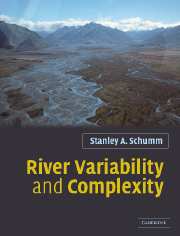Book contents
- Frontmatter
- Contents
- Preface
- Acknowledgments
- Part I Background
- Part II Upstream controls
- Part III Fixed local controls
- Chapter 9 Bedrock: alluvium
- Chapter 10 Tributaries
- Chapter 11 Active tectonics
- Chapter 12 Valley morphology
- Part IV Variable local controls
- Part V Downstream controls
- Part VI Rivers and humans
- References
- Index
Chapter 9 - Bedrock: alluvium
Published online by Cambridge University Press: 05 June 2012
- Frontmatter
- Contents
- Preface
- Acknowledgments
- Part I Background
- Part II Upstream controls
- Part III Fixed local controls
- Chapter 9 Bedrock: alluvium
- Chapter 10 Tributaries
- Chapter 11 Active tectonics
- Chapter 12 Valley morphology
- Part IV Variable local controls
- Part V Downstream controls
- Part VI Rivers and humans
- References
- Index
Summary
Bedrock, resistant alluvium and gravel armor constrain channel behavior and morphology (Figure 1.2). Rivers that are confined between bedrock canyon walls are obviously dominated by bedrock. However, many rivers are only partly affected by bedrock, and they vary greatly in their morphology and ability to adjust in a downstream direction. For example, the Snake River in Idaho (Osterkamp et al., 2001), the Middle Fork of the John Day River in Oregon (McDowell, 2001), and the Sabie River in South Africa (Heritage et al., 2001) are of this type. Mapping of 25 km of the Sabie River reveals that 5 km is bedrock anastomosing, 6.5 km is pool-rapid, 8 km is mixed bedrock and alluvial anastomosing, 1 km is single thread, and 4.5 km is braided, a very mixed bag.
For eight major rivers of the Northern Rocky Mountains in Idaho, it is obvious that the rivers are strongly influenced by the presence of bedrock, the nature or type of bedrock (resistant, soft, jointed, faulted), the presence of resistant alluvium in terraces and alluvial fans, colluvium (debris flows, rock falls), and glacial outwash. Reaches of these rivers were mapped in order to determine how much of the channels were controlled by bedrock, alluvial fans, and terraces, and indeed, a considerable portion of the bed and banks of these rivers is controlled by these variables (Table 9.1).
- Type
- Chapter
- Information
- River Variability and Complexity , pp. 97 - 103Publisher: Cambridge University PressPrint publication year: 2005



